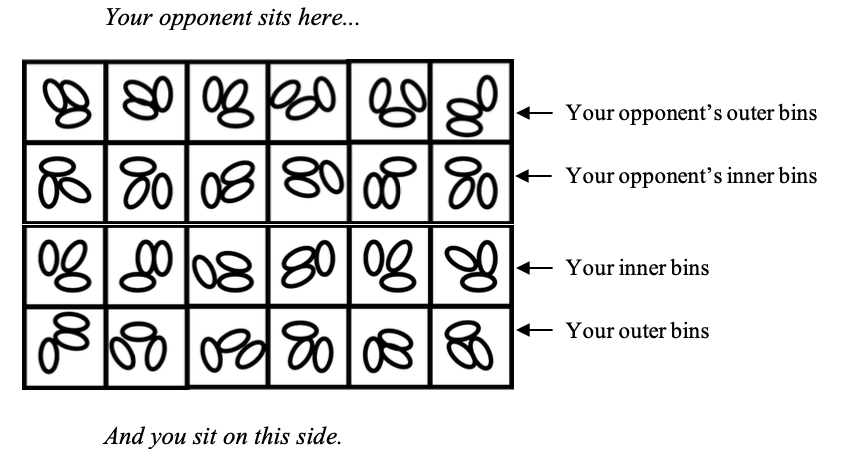I’m in the process of writing a curriculum for middle elementary that will include a story from the Kongo religious tradition, “Spider Steals Nzambi Mpungu’s Heavenly Fire.” As a supplementary activity, I’m planning to include instructions for Kisolo, a traditional Congolese game that resembles the well-known Mancala game that’s commercially available in the U.S. So here’s my first pass at Kisolo rules, somewhat simplified for middle elementary grades. (If you play this game, let me know what you think of the rules.)
To make a Kisolo board: Take two egg cartons, and cut their lids off. Tape them together to make a game board with six by four holes. (Most traditional Kisolo boards are four by seven holes in size, but a smaller board is allowable and makes for shorter game play.) You can also use he commercially available Mancala boards — take two of them, place them side by side and ignore the large bins at the ends of the boards.
To set up the board: Place three “seeds” in each bin. You can use actual bean seeds, or small glass tokens or what-have-you, for seeds. (For a faster game, plant only two seeds per bin.)

To start:
Two players sit at the long sides of the game board opposite each other. The twelve bins on your side belong to you, and the twelve bins on your opponent’s side belong to them. Each player has six “outer bins” (the row of bins nearest to them) and six “inner bins” — see the diagram above.
To play:
Youngest player starts.
When it is your turn, see if one of your inner bins contains seeds AND your opponent’s inner bin opposite it contains seeds. (If that’s true of more than one of your inner bins, just pick one; OR if you can’t capture any seeds, see below.)
Then remove all the seeds from your inner bin, plus the seeds in the corresponding bin that belongs to your opponent, and any seeds in your opponent’s outer bin that’s next to that inner bin.
Now “sow the seeds,” that is, starting with the inner hole you’ve just emptied, place one seed in each of your holes and continue counterclockwise sowing seeds only into you holes, until you have sown all the seeds.
If your last seed falls in one of your inner holes, then you ALSO get to remove all the seeds from your inner bin, plus the seeds in the corresponding bin that belongs to your opponent, and any seeds in your opponent’s outer bin that’s next to that inner bin. Then you sow the seeds as before—it’s like you get another turn (but after that your turn is over).
IF YOU CANNOT CAPTURE ANY SEEDS, then empty the seeds out of any one of your holes and sow those seeds counterclockwise into your own holes.
To win the game:
Capture all the seeds in your opponent’s INNER holes (doesn’t matter how many seeds are in the OUTER holes).
Note that some games will end in a draw, where neither player can win. If it feels like the game is going nowhere, the players can agree to a draw.
